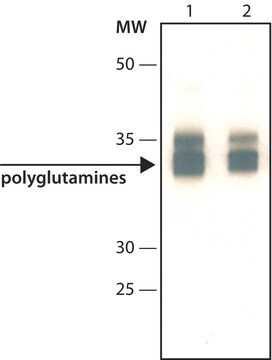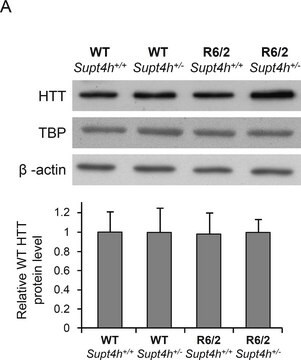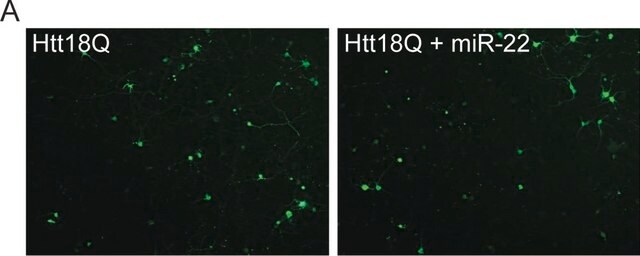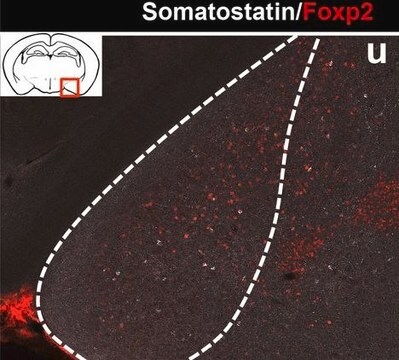MABN821
Anti-Huntingtin Disease (HD/HTT) Antibody
mouse monoclonal, 3B5H10
Sinônimo(s):
Huntingtin mutants with expanded polyQ repeats, HD protein, Huntington disease protein, mHtt, PolyQ disease proteins
About This Item
Produtos recomendados
Nome do produto
Anti-polyQ Disease Proteins Antibody, clone 3B5H10, clone 3B5H10, from mouse
fonte biológica
mouse
Nível de qualidade
forma do anticorpo
purified antibody
tipo de produto de anticorpo
primary antibodies
clone
3B5H10, monoclonal
reatividade de espécies
human
técnica(s)
electron microscopy: suitable
immunocytochemistry: suitable
immunohistochemistry: suitable
inhibition assay: suitable
western blot: suitable
Isotipo
IgG1
nº de adesão UniProt
Condições de expedição
ambient
modificação pós-traducional do alvo
unmodified
Informações sobre genes
human ... HTT(3064)
Categorias relacionadas
Descrição geral
Especificidade
Imunogênio
Aplicação
Immunocytochemistry Analysis: A representative lot immunostained neurons transiently expressing Huntington (Htt) or Ataxin-3 with disease-associated polyQ expansions (Q46 to Q138), but not neurons expressing Htt with Q17 or Ataxin-3 with Q27. Clone 3B5H10 stained diffuse mutant Htt (mHtt), but not aggregated Htt in large inclusion bodies (IBs) (Miller, J., et al. (2011). Nat. Chem. Biol. 7(12):925-934).
Immunohistochemistry Analysis: A representative lot immunostained brain tissue sections from transgenic mice expressing disease-associated human mutant Huntinton (mHtt) proteins, including murine strains BACHD (full-length mHtt with Q97), R6/2 (Exon 1 fragment with ~Q150), and YAC-SCA3 (full-length mHtt with Q84). Clone 3B5H10 stained diffuse mHtt and failed to stain tissue with extensively aggregated Htt unless strong antigen retrieval by 90% formic acid treatment was performed (Miller, J., et al. (2011). Nat. Chem. Biol. 7(12):925-934).
Inhibition Analysis: A representative lot prevented the aggregation of mutant Htt (mHtt) exon 1 fragment with Q39 or Q53 and disrupted pre-aggregated mHtt oligomers and fibrils into monomer in vitro by atomic force microscopy (AFM) and dynamic light scattering (DLS) measurement (Miller, J., et al. (2011). Nat. Chem. Biol. 7(12):925-934).
Western Blotting Analysis: A representative lot detected Huntington (Htt), androgen receptor (AR), and atrophin constructs with disease-associated polyQ expansions (Q65 to Q103), but not constructs with Q19 or Q25, exogenously expressed in HEK293 and PC12 cells. Clone 3B5H10 detected monomeric and possibly small oligomeric mHtt N-terminal fragments, but not large oligomers or high molecular weight aggregates (Miller, J., et al. (2011). Nat. Chem. Biol. 7(12):925-934).
Qualidade
Western Blotting Analysis: 0.5 µg/mL of this antibody detected exon 1-coded N-terminal Huntington fragment with 134-glutamine/Gln (134Q) expansion, but not the corresponding normal (wild-type) fragment with 17Qs.
Descrição-alvo
forma física
Outras notas
Não está encontrando o produto certo?
Experimente o nosso Ferramenta de seleção de produtos.
recomendado
Código de classe de armazenamento
12 - Non Combustible Liquids
Classe de risco de água (WGK)
WGK 1
Certificados de análise (COA)
Busque Certificados de análise (COA) digitando o Número do Lote do produto. Os números de lote e remessa podem ser encontrados no rótulo de um produto após a palavra “Lot” ou “Batch”.
Já possui este produto?
Encontre a documentação dos produtos que você adquiriu recentemente na biblioteca de documentos.
Nossa equipe de cientistas tem experiência em todas as áreas de pesquisa, incluindo Life Sciences, ciência de materiais, síntese química, cromatografia, química analítica e muitas outras.
Entre em contato com a assistência técnica




